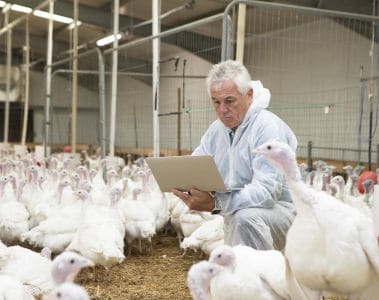
-
Global/EN
- Global
- North America
- Latin America
Our understanding of animal gut microbial communities has evolved over time. Recent advances in microbiome science encourage us to shift our perspective away from simply reducing the gut microbiota into either “good” or “bad” bacteria. With the sequencing and ‘omics revolutions, it is now possible to measure the functions that the microbiota perform, the metabolites they produce, and how they interact with each other and with their host. Focus is shifting away from taxonomy and toward the metagenome (the collection of genes from across the microbiota). The gut metagenome characterizes the functions the microbiome can perform as a community. A useful analogy is to think of the microbiome as an orchestra. The microbiota are the musicians, and the metagenome is all the possible music that the orchestra can play (Figure 1).
Focusing on taxonomy misses an essential property of the microbiome: Cooperation. The functionality of the microbiome depends less on which micro-organisms are present, and much more on what they do together.
A pivotal insight into the gut microbiome was discovered in the early 2010s in the Human Microbiome Project (Huttenhower et al., 2012). Scientists reported that the taxonomic profile of the microbiota differs remarkably among healthy individuals, even after correcting for diet or ethnicity. However, they found that the pathways of the microbiome, which determine their functionality, are very conserved among individuals. The same property holds true for animals.
The scientific community has recognized that the gut microbiome is more than a collection of micro-organisms. Rather, it should be viewed as a group of cells adapted for a specific functions. The important functions of the gut microbiome (Figure 2), interact with other systems in the body, and have specific physiology and pathologies.
Thinking about the microbiome as a functional unit reduces complexity. Instead of trying to understand complex changes in hundreds or thousands of species of micro-organisms, the focus shifts to ensuring that key functions (pathways) are being performed effectively and modulated to maximize performance, health, and sustainability.
The microbiome should be understood via its functions, not its individual cells. The collection of those functions is called the functional metagenome, which describes all the metabolic pathways of the microbiome. The use of advanced molecular biology tools such as whole genome sequencing together with data science has revealed the entire metagenome.
Such targeted approaches to understanding the microbiome has opened possibilities that were not considered in the past, like modulating pathways to utilize nitrogen or carbon more effectively, reduce emissions, enhance immune homeostasis, modulate animal metabolism and behaviour, or nurture epithelial development, beyond what is possible with the current gut health technologies. That means going from an unspecific approach of gut health additives development to a new, more targeted approach, where we can solve health, welfare, performance and sustainability issues more accurately and consistently.
Apart from the technological developments in molecular biology and data science, there is one critical enabler to make this a reality. The irreversible trend to remove antibiotics from animal diets has transformed the way the industry looks at the microbiome. With antibiotics out of diets, nutritionists have started looking at the microbiome as an important part of the system with a great potential, and not as a limitation.
Harnessing the stable metagenomic function of the microbiome is the next frontier in animal science. Rather that changing the musicians, our goal is to tune the music. Our search is not for new organisms or food to nourish existing organisms, but a conductor – a maestro that directs microbiome function to benefit the health and productivity of the animal, the environment and our customers.
13 September 2020
Maria Walsh is the Global Swine Marketing Director. Maria is an Irish national with a PhD in Animal Science from Purdue University in West Lafayette, Indiana, USA. She has more than 15 years of experience as a scientist and researcher. She joined dsm-firmenich in 2018 as a Senior Scientist, and has managed the swine innovation pipeline for the Animal Nutrition & Health business, including new product development and application solutions from ideation to commercialization.
We detected that you are visitng this page from United States. Therefore we are redirecting you to the localized version.